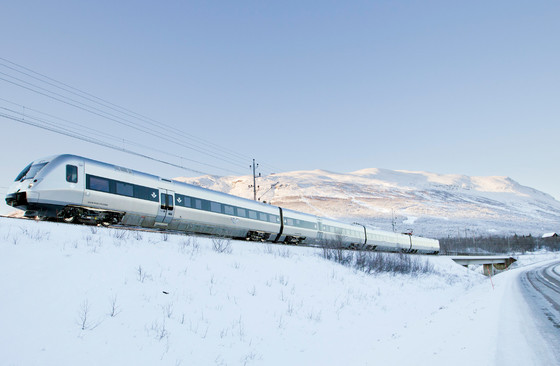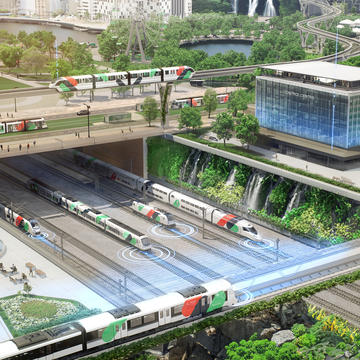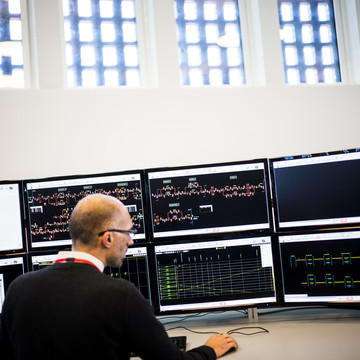
Norway's train control upgrade: Paving the way for sustainable transportation

Technology & Innovation Performance & Operations
Norway's train control upgrade: Paving the way for sustainable transportation
Moving people and things around the world creates a lot of pollution. In fact, it's responsible for more than a third of all energy-related carbon dioxide emissions[1]. That's why we need to find better ways to move. Norway, famous for its beautiful fjords and its dedication to protecting the environment, is taking a big step forward. They're upgrading their entire railway network, from the tracks to the trains themselves. This isn't just about making it easier to get from place to place. It's about using trains to cut down on pollution.
Tackling transport emissions requires a multi-faceted approach. The potential of modernised railway networks to move large volumes of people and goods with low environmental impact is immense. Norway’s transformative project includes modernising over 4,200 kilometres of track and equipping more than 400 trains with cutting-edge train control technology. This project success relies on collaboration among various stakeholders, including providers of trackside signalling, train management, and Alstom, playing a key role in integrating the intelligence onboard the trains that weave the rail network together.
Jean Philippe Garbit
Managing Director Digital & Integrated Systems Nordics at Alstom
System integration of ERTMS onboard intelligence
At the heart of Norway’s railway evolution is ERTMS (the European Rail Traffic Management System). Initially designed to standardise Europe’s diverse signalling systems, ERTMS has become a global benchmark for train safety and efficiency. Train signalling systems control how trains move, ensuring safe and efficient operations by managing train speeds, routes, and stopping points.
Integrating ERTMS into Norway’s diverse fleet of trains is a complex undertaking. Each train needs specific onboard signalling systems, carefully configured to ensure seamless communication with the new digital infrastructure. This requires precision engineering and advanced planning. To manage this our engineers, use advanced 3D modelling tools and integrated workflows. The tools help them create cloud-based digital twins of the trains and railway system, enabling visualisation and anticipation of potential challenges. "In Norway, 3D modelling and digital twins have proven indispensable in optimising the design for a large diversity of fleets and ensuring quality and timely project delivery," highlights Jean-Philippe Garbit, Managing Director Digital & Integrated Systems Nordics at Alstom.
Onvia™ Mainline Signalling
Alstom's advanced train control system, enhancing safety, efficiency, and interoperability across rail networks through digital technology. Built upon extensive global experience in mainline signalling.
Long-term commitments and innovative solutions for Norway
The deployment of ERTMS is not simply a technological upgrade; this represents a shift in how the railway operates. "ERTMS increase capacity on existing rail lines. It’s a fundamentally different approach, a continuous communication system that safely reduces the distance needed between trains, improving both capacity and reliability," explains Garbit. This increase in capacity through digital technology, provides a sustainable alternative to constructing new railway lines, which is both costly and environmentally disruptive.


Furthermore, ERTMS optimises train operations, precisely managing speed and braking, leading to improved punctuality, faster journey times, and a more reliable service overall. This enhanced efficiency makes rail a more attractive option for both passengers and freight, encouraging a modal shift away from more carbon-intensive forms of transport.
The long-term commitment to this technology is significant. "Our partnership with Norway extends beyond the initial installation of ERTMS since the signalling systems will have to be maintained to ensure the sustained performance and reliability of this critical technology," highlights Garbit. This project is also about continuous innovation. "We are using radar-less odometry, which makes train positioning more accurate and efficient, especially in harsh winter conditions. Additionally, to ensure a smooth transition to the new signalling system, we are implementing a smart bi-standard solution. This allows trains to operate on tracks equipped with the new ERTMS as well as older signalling systems, ensuring compatibility and efficiency."
Global knowledge, local impact
Looking beyond Norway, Thomas Denis, Vice President Mainline Signalling at Alstom, emphasises the global relevance. "Deploying ERTMS isn't just about installing technology off-the-shelf," he states. "It's about adapting to the specific nuances of each national railway environment. Our extensive experience with national ERTMS rollouts around the world provides us with invaluable insights that we directly apply to the Norwegian project."
Denis also highlights the long-term strategic value for other countries: "When we design and deploy these digital systems, we are always focused on long-term value and sustainability. Our technology is designed to be inherently upgradable. This gives infrastructure owners and rail operators the critical flexibility to adapt to evolving needs, incorporate new technologies, and continuously improve their networks without requiring massive, disruptive, and costly system replacements down the line."
Finally, Denis underscores the role of ERTMS in the future of rail: "ERTMS is the essential backbone of rail digitalisation. It’s the crucial foundation on which we can build even more advanced capabilities, including automated train operation." He concludes by: "Our work in Automated Train Operation (ATO) systems, building upon the ERTMS infrastructure in projects across the globe, showcases the next frontier in rail efficiency and capacity."
Norway's railway modernisation project is a strong example of the need to decarbonise transportation worldwide. It demonstrates how a strategic focus on digital technology, coupled with long-term vision and collaborative partnerships, can unlock the full potential of rail as a sustainable and efficient mode of transport. As countries worldwide seek to reduce their carbon footprint, Norway’s journey on the long haul towards a digitally connected and environmentally responsible railway provides a valuable roadmap.













